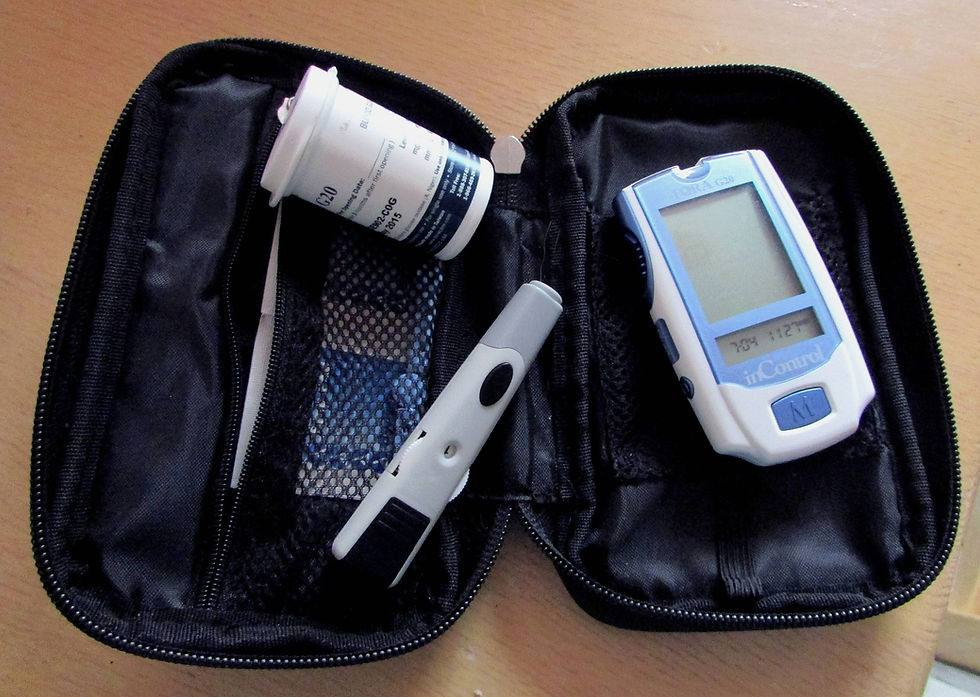Diabetes Awareness
- Lou and Teresa

- May 3, 2020
- 4 min read
Updated: May 4, 2020

To bring awareness to diabetes, the following information was taken from the Center for Disease Control website. What I’ve learned in reading up on diabetes is that it can strike most any of us. And that the percentage of adults with prediabetes who were aware they had the condition doubled between 2005 and 2016, but most continue to be unaware. I encourage each person reading this article to ask your doctors to include a diabetes status check with your next physical.
Resources for additional information are provided at the end of this article. As well I encourage you to speak to your Doctor should you have questions or concerns.
What is diabetes?
Diabetes is the condition in which the body does not properly process food for use as energy. Most of the food we eat is turned into glucose for our bodies to use for energy. The pancreas, an organ that lies near the stomach, makes a hormone called insulin to help glucose get into the cells of our bodies. When you have diabetes, your body either doesn't make enough insulin or can't use its own insulin as well as it should. This causes glucose to build up in your blood.
Diabetes can cause serious health complications including heart disease, blindness, kidney failure, and lower-extremity amputations. Diabetes is the seventh leading cause of death in the United States.
How prevalent is diabetes among blacks in America?
Blacks are 1.7 times as likely to develop diabetes as whites
The prevalence of diabetes among blacks has quadrupled during the past 30 years
Among blacks age 20 and older, about 2.3 million have diabetes – 10.8 percent of that age group
Blacks with diabetes are more likely than non-Hispanic whites to develop diabetes and to experience greater disability from diabetes-related complications such as amputations, adult blindness, kidney failure, and increased risk of heart disease and stroke;
Death rates for blacks with diabetes are 27 percent higher than for whites.
What are the symptoms of diabetes?
People who think they might have diabetes must visit a physician for diagnosis. They might have SOME or NONE of the following symptoms:
Frequent urination
Excessive thirst
Unexplained weight loss
Extreme hunger
Sudden vision changes
Tingling or numbness in hands or feet
Feeling very tired much of the time
Very dry skin
Sores that are slow to heal
More infections than usual
Nausea, vomiting, or stomach pains may accompany some of these symptoms in the abrupt onset of insulin-dependent diabetes, now called Type 1 diabetes.
What are the types of diabetes?
Type 1 Type 1 diabetes, previously called insulin-dependent diabetes mellitus (IDDM) or juvenile-onset diabetes, may account for 5 percent to 10 percent of all diagnosed cases of diabetes. Risk factors are less well defined for Type 1 diabetes than for Type 2 diabetes, but autoimmune, genetic, and environmental factors are involved in the development of this type of diabetes.
Type 2 Type 2 diabetes was previously called non-insulin-dependent diabetes mellitus (NIDDM) or adult-onset diabetes. Type 2 diabetes may account for about 90 percent to 95 percent of all diagnosed cases of diabetes. Risk factors for Type 2 diabetes include older age, obesity, family history of diabetes, prior history of gestational diabetes, impaired glucose tolerance, physical inactivity, and race/ethnicity. African Americans, Hispanic/Latino Americans, American Indians, and some Asian Americans and Pacific Islanders are at particularly high risk for type 2 diabetes.
Gestational diabetes develops in 2 percent to 5 percent of all pregnancies but usually disappears when a pregnancy is over. Gestational diabetes occurs more frequently in African Americans, Hispanic/Latino Americans, American Indians, and people with a family history of diabetes than in other groups. Obesity is also associated with higher risk. Women who have had gestational diabetes are at increased risk for later developing Type 2 diabetes. In some studies, nearly 40 percent of women with a history of gestational diabetes developed diabetes in the future.
Treatment for Type 2 diabetes
Treatment typically includes diet control, exercise, home blood glucose testing, and in some cases, oral medication and/or insulin. Approximately 40 percent of people with type 2 diabetes require insulin injections.
Can diabetes be prevented?
A number of studies have shown that regular physical activity can significantly reduce the risk of developing type 2 diabetes. Type 2 diabetes is also associated with obesity. However, type 2 diabetes can occur in thin people.
Is there a cure for diabetes?
In response to the growing health burden of diabetes mellitus (diabetes), the diabetes community has three choices: prevent diabetes; cure diabetes; and take better care of people with diabetes to prevent devastating complications. All three approaches are actively being pursued by the US Department of Health and Human Services.
Resources
The National Diabetes Education Program sponsored by CDC and the National Institutes of Health are working at the state and local level to deliver information and services to help African Americans take charge of their diabetes and take steps to avoid its devastating complications. More information is available by calling toll free 1-877-CDC-DIAB (232-3422) or by visiting the following Web sites: http://www.cdc.gov/diabetes/index.htm, http://ndep.nih.gov/, http://www.niddk.nih.gov/ or www.diabetes.org.
CDC Spokesperson: Jane Kelly, M.D. -- Director, National Diabetes Education Program CDC National Center for Chronic Disease Prevention and Health Promotion Phone: 404-639-3286

Please subscribe, tell your friends and visit us often at www.earringsoff.com. Send your email address to us at earringsoff@gmail.com to stay connected and hear about all the latest happenings! Our podcasts can be found on Apple Podcasts, Google Podcasts, Stitcher, Spotify, iHeart Radio and Blubrry.



Comments